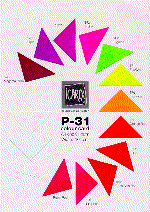

Fanø is an Island on the West coast of Denmark. It has 9 km long and 300...500 m wide beach, hard enough to drive on by cars and trucks. And most important: Wind - clean, smooth... usually enough... some times, more than enough... In mid June 1994 the 10th International Kite Flyers Meeting took place on Fanø. The meetings have been organised by Volfgang and Rainer and have been dominated by German kite flyers, but it's getting more international year by year. 1994 we had 21 rec.kiters from seven countries in our meeting/party/indoors flying session
As the June came closer we quite correctly anticipated the problem we will have to recognize each other. No one had ever met any other face to face. We managed to get accommodation on the same camping ground, but decided to make a small banner to help identification. After some emails a banner with "n@r.k" was selected. n@r.k stands for "nordic@rec.kites".
We had good time and n@r.k name sticked to the group automatically. We used it and other people started to use n@r.k as well. Next winter we even got some 'applications' from kite flyers, who were interested to 'join' in n@r.k. We had lengthy and difficult discussion about having more 'members'. The conclusion was that because we don't know ourselves what a membership of n@r.k means we cannot 'take' more members. The contemporary interpretation of n@r.k is to mean the meeting and the group we had in 1993. In 1994 we all were on Fanø again, but a lot of other rec.kiters were there, too. Again we had good time, but similar groupings did not happen. We'll see how is 1995. n@r.k decided to challence other rec.kites groups in Rokkaku battle on Fanø 1995! Well, it took one more year and the challenge took place for 1996...
In-haul:
The SHORTER you make these legs, the TIGHTER the kite spins/turns, and the lift will be reduced because the keel will be brought forward. If you adjust the legs longer, the turns/spins widen and the lift will be increased because the keel is back, or the nose is forward.
Out-haul:Same as most kites, basically.
Shunt legs:
For a given setting of the in-haul legs, the shunt legs need to be set with "some slack", until the wind hits 6 MPH or so. They need to be dynamic (tight) before 8 MPH, or may experience "elsnapo". Here's how I set slack: I hold the tow points in my hands with the kite laying on it's back. I put my foot against the keel and pull the tow points. The spine flexes, the T (and spreaders) go back. If the shunts have not tightened with a "reasonable amount of T depression", then the shunts need to shortened. How much is "reasonable" before the the G-Force spreaders break? It's a matter of experience and opinion. Start out by setting slack for a small amount of depression (one "knots-worth" of slack), then you'll find you can add more. Watch the kite in flight. If the shunts are getting tight before 6 MPH (or so), add slack. So, you have two bridles in one: with the shunts slack, you're flying on cross-bridle, when the shunts go dynamic you're on the spine wrap! Not a bad deal is it? The X-bridle has several advantages over the spine-wrap, here's a few:
 Prusik knot is a kind of double lark's head knot.
Prusik knot is a kind of double lark's head knot.Making Prusik knot. (Image size 17 KB)
Prusik knot and its variants are used by mountain climbers; if they hang their lives on Prusik knot, you can do it to your kite!


When I sew Icarex, I'll wet it's surface with water. Water keeps panels together like glued. Icarex is available from many kite shops, if you cannot find it near you, contact Vlieger-Op or Shanti.
Icarex swatches (colors samples) above are scanned directly from fabric on white paper. The size of a JPEG-image you get by clicking a thumbnail image is about 300 KB, but it has 16 million color palette instead of 256 in thumbnails.
Use these images to setup a palette in your favourite paint software and you can previsualise your kite designs.
Note: Scanning and display technology will not render the colors exactly as human eye.
Vlieger-Op
Wateringkade 5a
2515 AK Den Haag
Holland
phone +31-70-3858586
fax +31-70-3838541
email: vliegop@euronet.nl
Selected Exel technical data:
Outer
Spar Short Relative .... Scale Weight Diam
Type Name Stiff. Weight Fact. g/m mm
=============================================================
Exel RCF 6 Strong RCF6S 0.70 0.96 0.92 32 5.9
Exel RCF 6 RCF6 0.85 0.66 0.96 22 5.9
Exel RCF 6 Ultra RCF6U 1.26 0.51 1.06 17 5.9
Exel RCF 7 RCF7 1.61 0.78 1.13 26 6.9
SkyShark Kite Products
330 W. Grand Ave.
El Segundo
CA 90245
USA
phone: +1-310-414-0977.
fax: +1-310-414-0007
http://www.eskimo.com/~sharkey
Selected SkyShark technical data:
Outer
Spar Short Relative .... Scale Weight Diam
Type Name Stiff. Weight Fact. g/m mm
=============================================================
SkyShark IIIP IIIP 1.00 0.41 1.00 14 7.1
SkyShark VP VP 1.11 0.49 1.03 16 7.1
SkyShark VIIP VIIP 2.11 0.80 1.21 27 8.4
In Europe, SkySharks are available e.g. from Vlieger-Op.
Beman-CDT
254, Avenue de Pressense
69625 Villeurbanne Cedex
France
phone +3372651430
fax +3378849752
Selected Beman technical data:
Outer
Spar Short Relative .... Scale Weight Diam
Type Name Stiff. Weight Fact. g/m mm
=============================================================
Beman Ultra Light 21 BeUL21 2.27 0.81 1.23 27 8.3